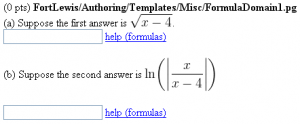FormulaDomain1
Answer is a Function with Domain Issues
This PG code shows how to set the domain and test points for a formula.
- PGML location in OPL: FortLewis/Authoring/Templates/Misc/FormulaDomain1_PGML.pg
| PG problem file | Explanation |
|---|---|
|
Problem tagging: |
|
DOCUMENT();
loadMacros('PGstandard.pl','MathObjects.pl','PGML.pl','PGcourse.pl');
TEXT(beginproblem());
|
Initialization: |
Context("Numeric");
$a = random(2,5,1);
$answer1 = Compute("sqrt(x-$a)");
$answer1->{limits} = [$a+1,$a+4];
$answer2 = Compute("ln(abs( x / (x-$a) ))");
$answer2->{test_points} = [[-5],[-4],[1],[$a-1],[7],[8]];
|
Setup:
We restrict the domain of function evaluation using
The domain for It is possible to set the domain once for all of the functions within a particular context. For more details, please see formula test points in the index of problem techniques. |
BEGIN_PGML
a. Enter the answer [`` [$answer1]= ``] [__]{$answer1}
b. Enter the answer [`` [$answer2]= ``] [__]{$answer2}
[@ helpLink('formulas') @]*
END_PGML
|
Main Text: Notice that in this multipart question we have grouped the text for each part together in a block, put each answer blank on a new line immediately below each block of text, and added extra space between each part. This should make the question easy to read both in HTML and PDF format. It is possible to get diagnostic information about the answer checker if one replaces the |
Context()->texStrings;
BEGIN_SOLUTION
${PAR}SOLUTION:${PAR}
Solution explanation goes here.
END_SOLUTION
Context()->normalStrings;
COMMENT('MathObject version.');
ENDDOCUMENT();
|
Solution: |
